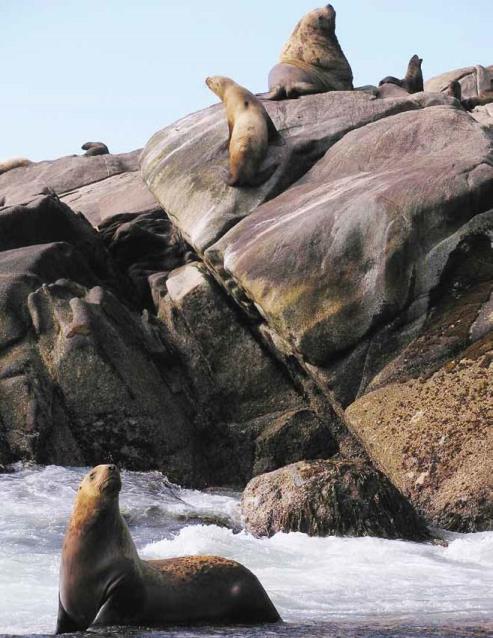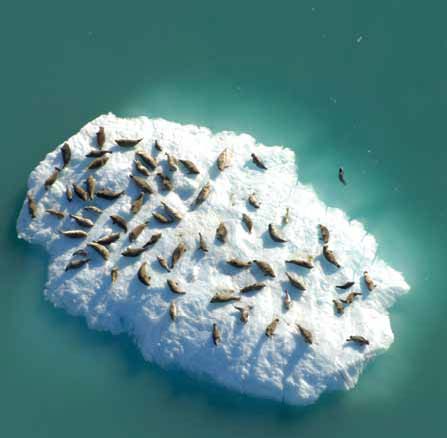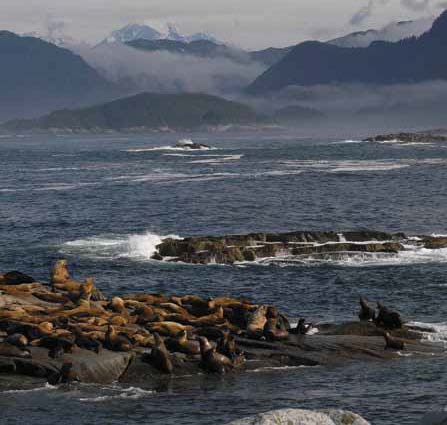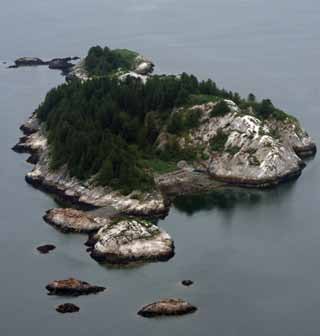Understanding long-term population trajectories for harbor seals and Steller sea lions is important as we might expect each species to respond to natural and anthropogenic change differently given their unique life-history characteristics.

Courtesy Kevin S. White, Alaska Department Fish and Game
Understanding the potential impacts of cruise ships or other vessels to marine resources in Glacier Bay requires not just a measure of the degree of their interactions but also the status and trends of those resources. Two marine mammal species of particular interest to park managers are harbor seals (Phoca vitulina richardii) and Steller sea lions (Eumetopias jubatus) due to their conservation status and potential to disturbance by vessels. Both species are apex-level predators and are highly sought after viewing experiences for visitors. Steller sea lions, which are currently listed under the Endangered Species Act (ESA), have a prominent haul out site at South Marble Island where private and tour vessels regularly visit. Harbor seals have been designated as a “species of special concern” in Alaska by the U.S. Marine Mammal Commission, and vessels regularly visit Johns Hopkins Inlet in the West Arm of Glacier Bay where approximately two-thirds of the seals in the park are found on icebergs calved from tidewater glaciers (Mathews and Pendleton 2006, Womble et al. 2010).
Given the conservation concerns associated with both of these highly visible marine mammal species, population monitoring efforts by various agencies and academic institutions were initiated a number of years ago and have since spanned several decades in the Glacier Bay region. In fact, Glacier Bay is one of only two glacial ice sites in Alaska where long-term monitoring efforts for harbor seals have occurred since the 1970s (Streveler 1979, Calambokidis et al. 1987, Mathews and Pendleton 2006, Womble et al. 2010).
The results of these monitoring efforts demonstrate surprisingly contrasting trends for the two species. For harbor seals, dramatic declines have occurred in Glacier Bay over the 17-year period from 1992-2008 at both glacial ice and terrestrial haul outs (Mathews and Pendleton 2006, Womble et al. 2010). The steepest declines (-11.5%/year) occurred at terrestrial sites from 1992-2001 and 2004-2009. At the primary glacial ice site in Johns Hopkins Inlet, pup counts had a significant negative trend of -5.0%/year for the 15-year period from 1994 to 2008, while the number of non-pups counted in August declined at -8.2%/year from 1992 to 2008 (Mathews and Pendleton 2006, Womble et al. 2010). In contrast, Steller sea lions in the Glacier Bay region have increased at a rate of 8.2%/year from the 1970s to 2009, with the most rapid growth at South Marble Island (16.6%/year from 1991-2009) (Mathews et al. 2011). The growth in the number of Steller sea lions counted in the Glacier Bay region represents the most rapid growth for the species in Alaska (Mathews et al. 2011) and is concurrent with the overall growth of the eastern population segment of Steller sea lions, which has increased at a rate of 3.1%/year from the 1970s to 2004 (Pitcher et al. 2007).
The decline of harbor seals in Glacier Bay is surprising given that the park is one of the largest northern temper- ate marine reserves (949 mi2/2,457 km2) in existence. During the breeding season, regulations are in place to protect harbor seals including closures of important seal pupping areas to vessel traffic and restrictions on approach distances by vessels. Though, compliance by cruise ship and other vessel operators in Johns Hopkins Inlet to these approach-distance regulations was found to be low (Young 2009). There also exists a prohibition of subsistence hunting for seals since 1974 (Catton 1995), and commercial fishing in Glacier Bay proper is being phased out. The decline in the number of harbor seals counted in Glacier Bay is particularly perplexing given that population trajectories in other regions (Ketchikan and Sitka) in southeastern Alaska have been increasing or stable (Small et al. 2003).

NPS/Jamie N. Womble
In response to declines in harbor seals, research was initiated by the NPS in 2004 to address hypotheses related to the decline including assessing human disturbance at harbor seal haulouts as a result of vessel traffic, determining health and disease status, and identifying habitat use and movement patterns of seals during the overwinter-period when disturbance and vessel protections are not in place.
Several lines of evidence suggest that the Glacier Bay region may be particularly favorable for Steller sea lions. First, sea lions have colonized several new haulouts and a rookery at Grave Rocks (Pitcher et al. 2007, Womble et al. 2009, Mathews et al. 2010). Second, South Marble Island, the primary Steller sea lion haulout site, was colonized by sea lions as recently as 1985 and was used only seasonally through the 1990s. However, South Marble Island is currently occupied throughout the year by sea lions with breeding season counts exceeding 1,100 sea lions (Womble et al. 2009, Mathews et al. in press). Third, foraging opportunities are likely favorable for sea lions in Glacier Bay as it relates to the availability of spring-spawning fish aggregations (see photo below) (Womble et al. 2005) and the colonization of salmon of Glacier Bay (Milner and Bailey 1989). Both of these prey resources likely provide high- energy densely aggregated prey for sea lions at critical times of year (Womble et al. 2009). Finally, the increase in the number of sea lions counted in the Glacier Bay region is of particular interest as it relates to the decline of sea lions in the western population (Mathews et al. in press). Recent genetic evidence suggests that Steller sea lions from both the eastern and western populations colonized the Graves Rocks sea lion rookery in the Glacier Bay region (Gelatt et al. 2007, O’Corry-Crowe et al. 2007).

Courtesy Bill Eichenlaub
It is currently unknown if there is a relationship between the population trajectories of these two pinniped species. Steller sea lions and harbor seals use similar foraging habitat and consume similar prey species including walleye pollock, capelin, Pacific sandlance, herring, and salmon in the Glacier Bay area (Gelatt et al. 2007, Herreman et al. 2009). Such foraging overlap could result in negative population-level effects on harbor seals if prey become limiting, and sea lions are able to out-compete seals for these resources. Dramatic changes in the landscape due to rapid glacial retreat may also influence harbor seals and Steller sea lions differently given their life-history strategies. For example, between 1973 and 1986, the Muir Glacier, a tidewater glacier in the East Arm of Glacier Bay, retreated more than 4.3 miles (7 km). The dramatic retreat and subsequent grounding of the Muir Glacier resulted in the cessation of calving of the Muir Glacier in 1993 (Hall et al. 1995). As a result, the availability of floating glacial ice as a haulout substrate for harbor seals in Muir Inlet was reduced and eventually resulted in the abandonment of upper Muir Inlet by harbor seals. Prior to the grounding of Muir Glacier, at least 1,347 seals were counted in upper Muir Inlet in the East Arm of Glacier Bay in the 1970s (Streveler 1979); however, in 2008 fewer than 200 seals were counted in McBride Inlet near the terminus of the McBride Glacier, which is the only remaining tidewater glacier in the East Arm of Glacier Bay (Womble et al. 2010).

Courtesy Kevin S. White, Alaska Department of Fish and Game
In 1879 John Muir visited Glacier Bay and wrote of “the whiskered faces of seals that dotted the open spaces between the bergs” (Muir 1915). Clearly changes in the population dynamics of seals and sea lions are occurring in Glacier Bay. Understanding long-term population trajectories for harbor seals and Steller sea lions is important as we might expect each species to respond to natural and anthropogenic change differently given their unique life-history characteristics. Ultimately, long-term population monitoring programs are critical component of park management as they provide estimates of population trends of species of conservation concern and can be used to inform decisions regarding management actions that may have potential to adversely impact these species.
Acknowledgements

NPS/Jamie N. Womble
We would like to acknowledge G. Streveler, J. Calambokidis, and E. Mathews for the initiation of pinniped monitoring in Glacier Bay, as well as numerous individuals that have assisted with the surveys. G. Pendleton (Alaska Department of Fish and Game) has graciously provided biometric support. Numerous agencies and institutions have provided funding, personnel, and logistical support including the National Park Service, Glacier Bay National Park and Preserve, University of Alaska Southeast, University of Alaska Fairbanks-School of Fisheries and Ocean Sciences, Alaska Department of Fish and Game, Alaska Fisheries Science Center- National Marine Mammal Laboratory, Moss Landing Marine Laboratory, and the Ocean Alaska Science and Learning Center. Support was also provided through an Albright-Wirth Grant to J.N. Womble through the National Park Foundation and National Park Service-NRPP Grant PMIS #35747 to Scott Gende.
References
Calambokidis, J., B.L. Taylor, S.D. Carter, G.H. Steiger, P.K. Dawson, and L.D. Antrim. 1987. Distribution and haul-out behavior of harbor seals in Glacier Bay, Alaska. Canadian Journal of Zoology 65: 1391-1396.
Catton, T. 1995. Land reborn: a history of administration and visitor use in Glacier Bay National Park. National Park Service.
Gelatt, T., A.W. Trites, K. Hastings, L. Jemison, K. Pitcher and G. O’Corry-Crowe. 2007. Population trends, diet, genetics, and observations of Steller sea lions in Glacier Bay National Park, Alaska. In Proceedings of the Fourth Glacier Bay Science Symposium: U.S. Geological Survey Scientific Investigations Report 2007-5047, edited by J.F. Piatt and S.M. Gende. U.S. Geological Survey. Reston, Virginia.
Hall, D.K., C.S. Benson, and W.O. Field. 1995. Changes of Glaciers in Glacier Bay, Alaska using ground and satellite measurements. Physical Geography 16: 27-41.
Herreman, J.K., G.M. Blundell, and M. Ben-David. 2009. Evidence of bottom-up control of diet driven by top-down processes in a declining harbor seal Phoca vitulina richardsi population. Marine Ecology Progress Series 374: 287-300.
Mathews, E.A., and G.W. Pendleton. 2006. Declines in harbor seal (Phoca vitulina) numbers in Glacier Bay National Park, Alaska, 1992-2002. Marine Mammal Science 22: 170-191.
Mathews, E.A., J.N. Womble, G.W. Pendleton, L.A. Jemison, J. Maniscalco, G. Streveler. 2011. Population growth and colonization of Steller sea lions in the Glacier Bay region of southeastern Alaska: 1970s to 2009. Marine Mammal Science.
Milner, A.M., and R.G. Bailey. 1989. Salmonid colonization of new streams in Glacier Bay National Park, Alaska. Aquaculture and Fisheries Management 20: 179-192.
Muir, J. 1915. Travels in Alaska. Houghton-Mifflin. Boston.
O’Corry-Crowe, G., B.L. Taylor, T. Gelatt, T.R. Loughlin, J. Bickham, M. Basterretche, K.W. Pitcher and D.P. DeMaster. 2007. Demographic independence along ecosystem boundaries in Steller sea lions revealed by mtDNA analysis: implications for management of an endangered species. Canadian Journal of Zoology 84: 1796-1809.
Pitcher, K.W., P.F. Olesiuk, P.F., R.F. Brown, M.S. Lowry, S.J. Jeffries, J.L. Sease, W.L. Perry- man, C.E. Stinchcomb, and L.F. Lowry. 2007. Abundance and distribution of the eastern North Pacific Steller sea lion (Eumetopias jubatus) population. Fishery Bulletin 107: 102-115.
Small, R.J., G.W. Pendleton, and K.W. Pitcher. 2003. Trends in abundance of Alaska harbor seals, 1983-2002. Marine Mammal Science 19: 344-362.
Streveler, G. 1979. Distribution, population ecology and impact susceptibility of the harbor seals in Glacier Bay, Alaska. Unpublished Report. Glacier Bay National Park and Preserve.
Womble, J.N., M.F. Willson, M.F. Sigler, B.P. Kelly, and G.R. VanBlaricom. 2005. Distribution of Steller sea lions in relation to spring-spawning fish in SE Alaska. Marine Ecology Progress Series 294: 271-282.
Womble, J.N., M.F. Sigler, and M.F. Willson. 2009. Linking seasonal distribution patterns with prey availability in a central-place forager, the Steller sea lion. Journal of Biogeography 36: 439-451.
Womble, J.N., G.W. Pendleton, E.A. Mathews, E.A., G.M. Blundell., N.M. Bool, S.M. Gende 2010. Harbor seal (Phoca vitulina richardii) decline continues in the rapidly changing land- scape of Glacier Bay National Park, Alaska, 1992-2008. Marine Mammal Science 26: 686-697.
Young, C. 2009. Disturbance of harbor seals by vessels in Johns Hopkins Inlet, Glacier Bay National Park, Alaska. M.S. Thesis. San Jose State University.
Part of a series of articles titled Alaska Park Science - Volume 9 Issue 2: Glacier Bay Scientific Studies.
Last updated: October 23, 2021
